China 2010
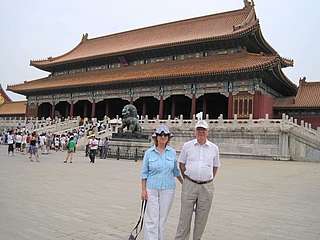
Fragments from China - the end of June, beginning of July 2010
Where to start with stories from China? The country is large, complicated, we acquired a lot of new experience but the time was short. I would like to share with readers part of this knowledge about the country which we managed to acquire in this limited period of time and which might be of interest to all.
Comparisons. From the outset I want to emphasize that we were able to see only one side of China, the more positive one, as we visited only the western part of the country and besides the inspection of the manufacturing plant for grinding equipment for limestone about 200 km inland, we were mostly in the cities. The villages on the way to this plant looked poor but not terrible. . And what we saw in the cities surprised us to no end. China is at least 20 years ahead of India, has a perfect infrastructure, good roads, several new bridges in each city, well-functioning public transport system (metro, new spacious buses), uniform taxis in Shanghai (Volkswagen Passat brand – of course government went one category higher, they all use black Audi limousines), high speed internet flawlessly functioning in all hotels with the exception on the ship. No slums at the outskirts of the cities and although the apartments in new high-rise buildings are very small (typically only a kitchen and one room for all family consisting of father, mother, one child, sometimes even grandmother), the huge progress cannot be overlooked. All clean, no garbage, no dog excrements on the streets, large perfectly maintained parks in all the towns as well as maintained green stripes separating two directions on the highway. Almost no beggars, with the exception of a couple of handicapped at Buddhist temples, definitely no begging children. All unlike India.
Religion and philosophy. The first Shang Dynasty was founded around 1600 BC, the first evidence of the scripture which was discovered is dating from around 1300 BC! In the years 771-221 BC Zhou Dynasty came to power – it was time full of political and social conflicts and Confucianism and Taoism arose out of these turbulent times. Confucius (551 BC -479 AD) created by his Book of Changes, apparently the oldest surviving philosophical document of all times. The subsequent Taoism underscores the relativity of all things (a philosophy close to my heart) and includes the traditional concept of complementary and contrasting , and the same time both negative and positive forces of yin and yang, and directed energy qi. Chines letter qi depicts a bowl of rice with rising steam. On the other hand qi represents in China a guiding principle in traditional science and art. Feng shui (wind and water) originated from the principle qi. The plan of the buildings has to be designed and rooms furnished based on feng shui so that good health and well being of the residents would be ensured. Acupressure, qigong (deep breathing exercises) and martial arts (kung fu) are based on the principles of qi as well. The monks of Shaolin kungfu monasteries undergo an extraordinary discipline and are able to achieve absolutely exceptional physical performance proving their fitness and endurance. We could watch this in a unique performance at the Red Theatre in Beijing. The theatre staged a story about a boy whom his mother brought to the monastery and handed him over to the abbot to study the philosophy of kung fu. The story was accompanied by wonderful performance of little boys around six years old, young men about eighteen and also older men, who achieved mastery in the art of kung fu. The abbot was explaining to the young boy (and to the audience) the function of kung fu for defense only – how to master it means constant self-denial, sacrifice and training.
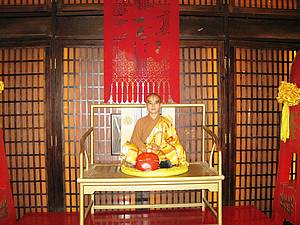
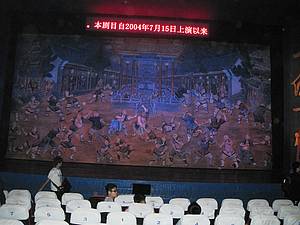
00 -Beijing Legend of Kungfu in the Red Theatre
The third part of the spiritual life in China is Buddhism, which began to spread in China only gradually starting 1st century AD. The first Buddhist temple is reportedly the White Horse Temple in Luozangu from the year 68 AD, the well known Longmen Caves come from the same region. The beginning of their creation dates back to the 4th century AD and the work on them continued during the Tang Dynasty, before the ethnic cleansing against Buddhists suddenly interrupted further development. Number of carved statues exceeds one hundred thousand (their beauty and origin remind Indian caves of Ajanta and Elora). The real expansion of Buddhism occurred only in the 7th century from India. Buddhism school called Mahayana promises the enlightenment to anyone seeking it, and emphasizes compassion and self-sacrifice. Buddhism in Tibet took over many features of original local shamanic Bon religion including various rituals and deities (the main part of Buddhism is the belief in reincarnation and good or bad karma acquired in the previous life.) Even today Buddhism for many Tibetans melts with everyday life and it is not possible to distinguish the border between the two – there is even no expression for religion in Tibetan language.
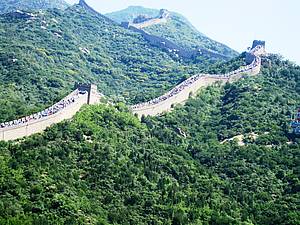
01 - Beijing - Great Chinese Wall
History. The wars for power among many rivals ended in 221 BC, when Qin Shi Huangdi of the Han Dynasty unified the country and declared himself the first Chinese Emperor. That was the Emperor who built the Great Wall as a defense against enemies.
At the same time created an army of terracotta warriors, because he believed that after death they will be protected by them against numerous enemies. The terracotta army was discovered in Xian in 1976 while digging a well and belongs to the most impressive monuments we saw in China. The establishment of the Han Dynasty was a golden age in Chinese history. Social organization was based on Confucian principles. Taoism and the theory of yin-yang freely complemented each other and together with the apotheosis of ancestors formed the basis of Chinese philosophy.
Han and Minorities. The majority of the Chinese population is now called Han, the rest are so-called "minorities" (all our guides referred thus in a general way without nearer specification to all those who were not Han – although they belong to 55 different ethnic diverse minorities – but they represent only 7% of the population). The situation of minorities in China is mainly discussed in connection with Tibet. Instead of further oppression the official policy started to show their culture as a tourist attraction: a large section in Shanghai Museum is devoted to costumes, masks and habits of 'minorities', during an evening drive around the lakes in Guilin there were various ethnic minorities waiting on the banks and presenting their dances and songs (incredibly romantic show as all is beautifully lit), also a tour on the Yangtze Tampan was guided by a local helmsman who sang for us a song in his native language. Everywhere in the cities, markets and shops there were sold products made by ethnic minorities, some of them very much different from typical Chinese art (especially the beautiful embroidery). The profit from sales if the shops belong to the state goes to the development of the “ethnic” areas and many shops present manufacturing of the products on spot, so that some members of these minorities l get also a job out of it. According to our judgment, the attitude to minorities in China is very paternalistic, as if they were people of the past and there would be a need to take care of them. It would be possible to judge if minorities themselves like or at least accept this attitude only if we could have travelled also through the western and northern parts of China (Tibet, Inner Mongolia, etc.). On the other hand, it is probably better, especially for young people when they are drawn to modern society than if they were sitting in their native village without clean water and electricity as in the Middle Ages, although this would contribute to preserving local traditions. Specifically in the regions with minority population, the construction of massif infrastructure, roads and dams goes on. But on the other hand also education seems to be an important issue - we heard that there was a mandatory quota for admission of "minorities" at the universities and into the civil service.
When summarizing the history of a country, whether it is Iran, Vietnam or any other country, even Europe, since the beginning of our era there have always been alternating periods of peace and war, be it civil wars or fights against external invaders, and rotation of different dynasties whose members kept murdering each other in the eternal seek for power. The same in China. Chinese main dynasties: Sui Dynasty (589), Tang Dynasty (618-907 – time when Buddhism spread from India), Liao (907-1125), Five Dynasties and Ten Kingdoms (907-960), Song Dynasty (960-1279), Jin Dynasty (1115-1234), the Dominion of Mongols ( at the forefront of well know Genghis Khan and his son Kublai Khan - 1279-1368). And finally two dynasties, which governed long, brought a relative stability and whose achievements in architecture and art are admired till today: Ming Dynasty (1368-1644 – compared with European history, approximately from the time of Charles IV till Thirty Years War) and Qing Dynasty (1644 - 1911 – which ended before the First World War in Europe started).
At the time of the Ming Dynasty Peking / Beijing became the capital city and the so called Forbidden City, which separated the Emperor from the neighborhood and assured his safety was constructed. The Great Wall was reinforced and expanded. In the 15th century, China became a major maritime power and its ships exported white and blue porcelain, silk, tea, and other luxury items to the Middle East and Europe. That was also the time when all types of arts and literature (drama and classic novels, the most famous of them Journey to the West) flourished. Late Ming Dynasty government was shaken by uprisings of oppressed peasants, by attacks of Japanese pirates and Mongol tribes and by the excessive power of the eunuchs - all these elements eventually led to its downfall.
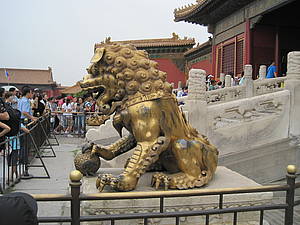
02 - Beijing - Forbidden City - Ming Palace
Qing Dynasty originated after unification of fragmented tribes by Manchurian leaders which paved the way for the conquest of Beijing in the year 1644. China found itself in fact under a foreign rule, however, the Manchu rulers supported the dual administration: every important place was occupied by both Manchu and Chinese officials which lead to an intense fusion of the two ethnic groups on the private level. On the other hand, the Manchu emperors tried to separate and protect their privileges and cultural traditions. However, during the 19th century they began to lose control, partially also because of the interference of European countries, for whom the trade with China became most profitable. After the opium trade was prohibited by the imperial decree, Britain wanted to continue this profitable business and demanded compensation for the confiscated opium. The first Opium War broke up in 1840: the British won and as per the Treaty of Nanking, the Chinese had to open up for free trade five major ports, to cede Hong Kong territory to Britain and to pay reparations. The Second Opium War and many other conflicts followed – in the end China lost. The split country, although its army was outnumbered, was unable to defend itself against the World Powers. The so-called “unequal treaties” handed over the full administration of Hong Kong to the British for 99 years (1898). A famous, or better to say, rather infamous, figure of this time was the Empress Cixi (the Chinese pronounce it "Sisi", in the same way as the name of famous Habsburg empress, so we were confused at the beginning). A very conservative and power-hungry woman, originally Emperor's concubine, got gradually rid of her husband, allegedly also of her son, sister, co-governing concubine as well as of other potential adversaries. It was the most powerful woman on the throne of that time (1861 - 1908), her power was greater than the power of Queen Victoria. After her death, the throne fell into hands of three years old boy known as "The Last Emperor" Puyi, pictured in a famous film by Bertulocci. He ruled in two periods, first from 1908 to 1912, and as a puppet ruler also 12 days in 1917. According to the film, Puyi represented hope for unification and modernization of China, because he had a Scottish teacher and a good orientation in both Asian and in European cultures. But it was too late to make this hope fulfilled.
Modern history. The Republic of China was proclaimed 1st January 1912 by the first president Sun Yat-sen, belonging to the then still united Kuomintang movement. When former general of Xing dynasty tried to restore the Empire, it caused a huge wave of unrest, because the population still remembered Manchu domination, characterized by brutal repression of any revolt. After the death of the general, China remained politically divided. Although the Beijing government was internationally recognized, it was weak and almost helpless, so that the military leaders (warlords) were gaining an unlimited power in their territories. In 1920, the Kuomintang led by Chiang Kai-shek managed to re-unify China under the pretext of a transformation into a democratic state but he introduced one party policy, which meant that members of the Communist Party and other parties were persecuted, imprisoned and tortured. Only the beginning of the World War II forced the Nationalists of Kuomintang and the Communists to collaborate again. After many minor incidents between the two countries, Japan attacked China in 1937. The war was conducted with oriental cruelty and under the non compliance with international rules for protection of civilians (we recently watched an excellent video film on this topic, called Children of the Silk Road about British reporter George Hogg, who originally came to China to document the mass murders committed by the Japanese, but eventually decided to divert to safety traumatized children from Chinese orphanage, even if he risked during this action his life much more than it would have been the case if he stayed only as a reporter).
Although China belonged to the victorious powers of World War II, at the end of the war it was completely bankrupt. Another dispute between the Kuomintang and the Communists led to the resumption of the civil war. The Communists emerged as victorious and on 1st October 1949 Mao Zedong proclaimed on the Tiananmen square the People's Republic of China, called in a Chinese terminology New China. Kuomintang led by Chiang Kai-shek retreated to the island of Taiwan, which had not become a part of China until today (unlike Hong Kong and Macau). The government of Mao Zedong and the Gang of Four slowed down the postwar development of China for many years. Especially the Cultural Revolution, which prevailed in its drastic form from 1966 to 1971, and was promoted in a mitigated form until Mao's death in 1976, cost lives of many people and meant a loss of the intellectual elite of the country.
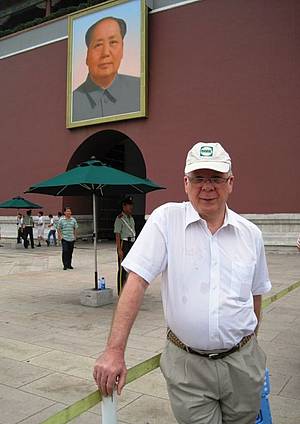
03 - Beijing - Tiananmen Square, Gate of Heavenly Peace - Mao Tse Tung
Present. In the eighties, however, the country began to open up and has experienced an incredible rise since then. Foreign investment is continuously flowing into a variety of industries, the labor cost is still very low. The average monthly salary is 7,000 yuan, which is about $ 1,000, but the figure is distorted by inclusion of a large number of really rich people, politicians, entrepreneurs and artists whose income improves the overall low average. A worker in factory for enamel products earns 1,600 yuan, a university graduate gets as his first pay a little more than 2,000 yuan.
As tourists, although we met with various people and discussed with them, we did not meet with any clear signs of oppression and or lack of freedom of speech. People were talking with us openly, to be in touch with a foreigner is no longer forbidden fruit as it was thirty years ago. They were obviously uncomfortable with some questions which we asked them, but many of them knew how to deal with them. A local guide sang the praises for dam and power plant project of century Three Gorges. It has been known as one of the most contradictory water projects in the world. But when we imagine that it supplies 10% of the energy needed in China, so we can imagine as well how many more thermal power plants would have to be built if the dam did not exist, and what would be the impact of that for the atmosphere, how much fly ash would have to be disposed, and so on. The power station in Nashik produces about 900 megawatts, the Three Gorges have already 26 turbines, each producing more than 900 megawatts, and another ten turbines will be operational in the next few years. Those of you who are acquainted with Nashik thermal power station (which belongs to larger ones in India) can imagine that instead of Three Gorges system, thirty six thermal power stations such as the one in Nashik would have to be built!!! In my opinion, water is still the cleanest source of energy. Another advantage is that the region does not have flooding any more. It is organized in such a way that on the other hand, many tributaries have more water than before, which is good for irrigation and development of agriculture. But of course, nothing is only positive so I pointed out some problems which we heard of to our tour guide. The landscape changed, the evaporation from such a large water surfaces is significant, the area is actually under a kind of steady mist (that´s what we also experienced). The Guide flinched a bit when I mentioned that they had to move over a million people, how did they deal with that? However, she managed to explain quite well that many of these people lived in clay houses or even in caves, and now they were moved into a home with all the modern conveniences. Young people appreciated it because they were trying to escape the oppressive circumstances of their parents anyway. Obviously, older people were not happy because they felt that they had lost their roots, small huts where their families had lived for centuries, and the graves of their ancestors were flooded and it was difficult for them to assimilate to the new conditions. A compensation was paid to all (how much would be a meaningless question, as it would depend on the quality of property). The guide pointed out that according to the results of the latest survey 70% of people were happy in the new place of residence and 30% were not happy. She also explained how they tried to save dying species that lived in the river, by re-planting some of them e.g. Chinese sturgeon, which is protected and not allowed to be caught.
Three Gorges. Before starting our journey, we read in the press some reports about alleged technical problems during the construction of Three Gorges. However, these news must be based on an outdated and probably naive idea that the Chinese are not sufficiently experienced in this field. Just to illustrate that it is not the case, I will mention a little incident that confirms my and George's theory, that all numbers in China are beyond our normal standards and expectations. In the year 1974, when China became a member of the International Commission on Large Dams (ICOLD), a serious administrative problem appeared with the presentation of China´s dams in the World Register. The original idea was that the national committees of member states should include into this publication only dams over 15 meters of height. Chinese representatives announced that in the case of China it would be a truly extraordinary number, over 80,000 dams, which would obviously greatly disturb the proportionality of the document (to put it simply, the registry would be mainly Chinese). Therefore it was mutually agreed that in the case of China only the dams with height over 60 meters will be included. This little episode can document a great tradition in the construction of reservoirs and dams in China as well as the expertise and experience of Chinese dam builders. Currently the world's major water projects are being built and planned in China and many world-renowned company aspire to participate in tenders.
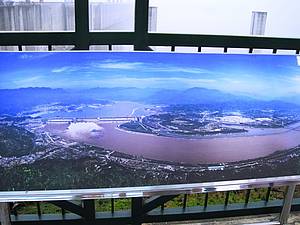
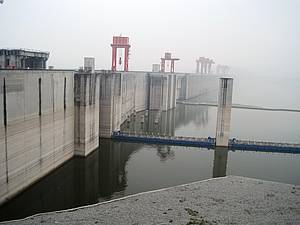
04-05 - Three Gorges Dam on Yangtse - from Victoria Ship
Political Agitation: To our surprise, we met very little of political agitation in the streets. In India, we encounter the posters and bill boards constantly celebrating various politicians everywhere, even for the petty occasion that some political celebrity has birthday. For this purpose his devoted supporters collect the money and erect in town big billboard "Happy Birthday, our beloved and best so and so". They are sucking up shamelessly and of course expect some remuneration later on. In China, we could see nothing like that - the only really big political poster with a portrait of Mao Zedong on Tiananmen Square, on the building from which Mao proclaimed the People's Republic of China, had its historical justification.
Freedom of Media: Our guide in Guilin disliked our question regarding the issue of blockage of some websites. We have to say that we had on our lap tops access to all the sites to which we needed to get, including Google, who was at that time in a serious dispute with Chinese government. However, the Guide conceded that the government keeps blocking some sites with political content, or that it censors some films (he did not utter the word pornography). Another guide in Xian, once he started to trust us, explained that English or German programs are not available even on the cable TV. But people who are interested, mount a satellite and get the English programs anyway. He also has a satellite, but it is illegal.
Keeping the Rules: We had a cute story with this Xian guide. Unfortunately, the whole journey to China was negatively marked by George´s backache, which even pain killers could not kill. The only position in which his back stopped hurting, was a sitting position. This meant that after some time of marching he just had to sit somewhere, either on a chair or on stairs, depending on the situation. The biggest attraction in Xian are terracotta warriors, over six thousand figures of soldiers and life-size animals. They were created by the first Chinese emperor Qin Shi Huang 2,200 years ago – in the same way as the Egypt´s pharaohs of that time, the Chinese were buried with objects that they might need in their afterlife. And the Emperor, who was a great warrior, who united China and built the Great Wall, considered quite reasonably that the most useful thing in his afterlife would be the military. The army of terracotta warriors was discovered in 1974. Since then archaeologists continue working at the reconstruction and rehabilitation of clay figures – so far they managed to glue together only a fraction of them. As always during this trip, a visit of this site was well organized, everything worked, tourists which got off from buses and cars were immediately transferred to open mini-cars that took them to the spot and let them marvel, with or without a guide, over one of the largest archaeological discoveries of the twentieth century. However, when the tour ended, it turned out that the mini cars would not take us back, as they were driving only in one direction and returning back to the gate empty. It was the moment that George could barely move and needed to sit down. Even I was not thrilled when I looked at the two miles long open road, without any shade, where we were supposed to go back – the temperature climbed in between up to the beautiful thirty eight degrees. I asked our Alex, why we could not be taken back, when the empty mini cars were returning the same way. Like everything in China, also this rule had an explanation. On both sides of the road stalls with various souvenirs spread. Local villagers complained to the mayor that if tourists had the opportunity to get into mini cars or trains and be taken back, ninety percent of them would do that and business of villagers would suffer. Therefore drivers of mini cars were not allowed to take anybody back. I explained to Alex the situation that George was in pain and I was tired and that I was going to ask one of the drivers to take us back. He was appalled – surely it was not possible to violate the rule and the driver would never do it. I told him just to let me talk and translate. Well, what do you think, that happened? Of course, the driver took us, he only required that we would sign that it was because of our condition so that he would not have problems. The guide was amazed. I showed him in the practice that if the rule is not reasonable it can be opposed and there must always be an exception to the rule, otherwise it would not be human. He was enchanted by the result of our joint intervention – as he admitted it would never come into his mind that he could challenge the rule.
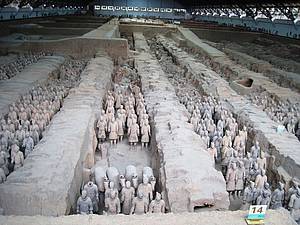

06 - Xian- Terracota Warriors 2000 years old
Names, language. All our guides had an original Chinese and an additional English name. They gave themselves the English name because stupid tourists would not be able to remember the Chinese name (they did not say it like that but that´s what it must be). So we had in Yichang a guide named Zuo Fei, with English name Coffee; in Chongquingu it was Pan Wei, in English Peter; in Guilin Li Huimin, in English Merrick (he was the only one who told us that we should call him Mr. Li, probably he was not enchanted by his English name), in Xian, it was Zhou Xin, in English Alex, and in Beijing, the only girl we had, was called Jia Kolo, who called herself Emma. The first guide we had in Shanghai spoke English poorly, so no real conversation was possible. All others mastered the language well, but the problem was pronunciation, they often did not understand us, and we sometimes did not understand them, although their knowledge of grammar and vocabulary was solid (often we had to spell the words to each other, to get the desired result and understand). It is still a handy cap that China as a country tries to overcome, because recently children started to learn English since the first grade.
Family policy: Our guides shared with us besides the mentioned historical overviews information on every aspect of life in China. One of the topics was the state's one-child policy. They told us stories of their families. In China, it is allowed to have only one child, if a woman gets pregnant for the second time she must get abortion. Only in the country, or if she belongs to a minority, she is allowed to have two children, especially when the first child is a daughter, because farmers need someone to take over their fields. Having two or more children is simply illegal. When someone wants to break this rule, it is difficult. Even if the pregnant woman went somewhere where no one would know that she already had one child before, it would not help much, because the newly born child would be in fact non-existent, would receive no papers, could not study etd. Therefore, a special permit must be obtained for the birth of the second, possibly third child, and this can be achieved by using your connections or by a bribe, the amount of which varies according to the circumstances, but it it a lot of money.
The guide in Guilin told us that because he already had an older brother, his birth cost his parents 80,000 yuan, which is about $ 11,500. His parents were obviously higher middle class, one uncle lived in U.S.A. in California, they also travelled (their son was joking about their travel all over Europe in 14 days, how they mixed up the churches which they saw everywhere), so they could afford it. But both the sons lived far away from their parents, they could see each other only once a year during the festival of spring (the most important family feast similar to our Christmas, with a moving date, usually in January of February) because the trip by train takes more than 24 hours and is costly.
The guide in Xian said that his parents were farmers, so the law allowed them to have two children. When he and his brother were born, two boys, his parents wanted, unlike others who want only sons and no daughters, to have a little girl too. So they paid about 6,000 yuan (meaning bribe) to be able to have the third child – however the third boy was born. All children left the village in the search for better life in the city, so for the same reason as in the previous cases, they were able to see each other only twice a year.
Emma, the only female guide whom we had in Beijing, was the only child, her parents were both teachers, so probably could not afford the bribe even if they wanted to have more kids. When I heard or read about the regulation of population in China, I had some understanding for that because I could imagine that a country like China did not want to have population explosion which would make it impossible to feed all its people. But whilst listening how it works in the practice I had some doubts if it is right to implement such a policy so strictly.
Women rights. When it comes to equality of men and women, women are represented in political offices and in other important jobs. In theory and according to the law, the equality of the sexes is guaranteed. However, Emma said that the discrimination existed. When women seek employment, most employers give preference to men quite bluntly, she had it from her own experience. When I asked her whether a woman could be a head of state in China, she smiled and said that she could not really imagine that. Chinese women in urban areas are elegantly dressed, they like to wear miniskirts, shorts and high heels, they prefer more western style with some oriental elements, they do not need to cover up their bodies (this is also different from India). The problem with any purchase for Europeans is the suitable size - even XXXL sometimes does not correspond to normal 42 size. The traditional Chinese quipao is usually easily obtainable only at the market. Students mostly wear sport pants, jeans and T- shirts.
Presence of police, traffic. We were also surprised that police officers are not frequently visible in the streets. Certainly the police presence was much stronger in Vietnam or Sri Lanka (in case of Sri Lanka it was understandable because when we visited the civil war just about ended). The change between a traffic policeman or a policewoman (in an attractive uniform miniskirt) takes place in the middle of the crossroad and includes a saluting ritual. Most drivers in the cities observe traffic rules, drive at the same speed, there is no chaos in the streets, the traffic lights indicate how many seconds it will take before the color changes, then everyone starts to move at the same moment (unlike in India, and possibly unlike in the Czech Republic). However, traffic jams in rush hour are unavoidable, there are simply already too many cars in China. An exception to the otherwise disciplined way of driving were the trucks which moved in the direction of Inner Mongolia (that is the same direction as when visiting the Great Wall). They changed the lanes unnecessarily, overtook as they pleased and behaved in a way that it was obvious that they realized who was stronger. Some of their maneuvers were dangerous, on the brink of an accident.
After the first three days in Shanghai, which were dedicated to business - we wanted to buy an equipment for grinding of residual ash - we started our holiday and visited in total six cities (we had four over flights). Our observations are noted below.
Shanghai
Skyscrapers as in Hong Kong or New York, a very inventive modern architecture, greenery, cleanliness. We stayed right in the heart of the busiest shopping streets in the world (Nanjing Street), where it must surely have been at least twenty-five large department stores next to each other, with the choice of goods often exceeding European selection.
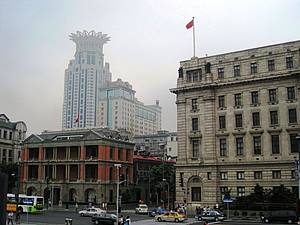
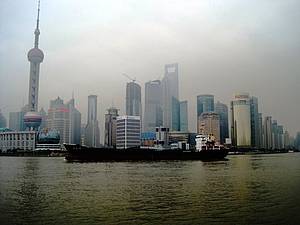
07-08 - Shanghai - Bund, Pundong Quarter
Expo was overcrowded – and as I dislike huge queues and masses of people, we only managed to get through into the Chinese pavilion and German pavilion (they let us go without a queue, because George is German). Czech pavilion had unfortunately two-hour lunch break (just to say it, no other pavilion closed for lunch, only the Czechs), so we could see it only from outside.
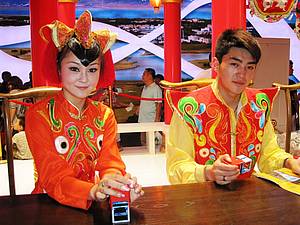
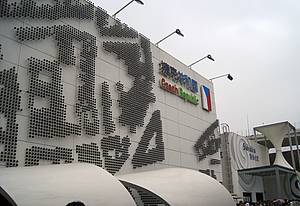
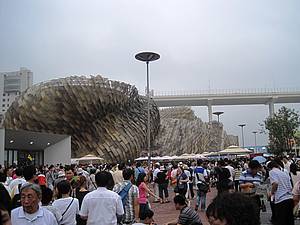
07-09 Shanghai EXPO 2010, Chinese Pavillion, Czech Pavillion, Overall View
We visited a silk factory where we were shown everything about silk production from the very beginning, silkworm larvae, changing into a cocoon of raw silk, winding of a very strong fiber and finally production of silk fabrics.
The French Quarter (French Concession) is linked to the history of urban development. Up to 1842 Shanghai was a meaningless river port. However, in this year China accepted the requirements of Western countries to grant trade concessions and Shanghai became, along with other ports, an outpost of European civilization. The Americans, British and French won in Shanghai its extraterritorial areas, the districts, where only the laws of their respective countries applied. As a result, the French Concession experienced an influx of a special mix of entrepreneurs, refugees, criminals and revolutionaries who contributed to the splendor and glory of Shanghai between the two wars. White guards who fled from Russia, Chinese and French, lived here together, the district had its own electricity supply, courts and police. However, later on, the harmony changed when Pockmarked Huang became a police president as he was at the same time a leader of the infamous Green Gang who controlled the opium trade. The French gave up the right for extraterritoriality only in 1940. Today there are small streets full of cafes, shops, galleries and bars in the French Concession, all in the style of Paris.
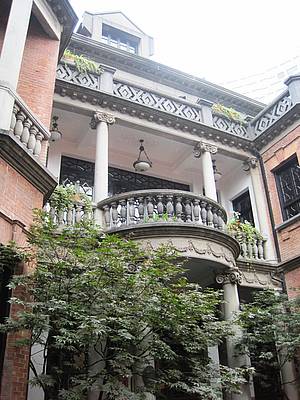
12 - Shanghai - French Concession Quarter
Shanghai Museum - Admission is free, but there was a queue for the security check. In front of me there was an about ten-years old boy who had exactly the same Canon camera as I had. He was queuing with his father, who accompanied him up to the entrance and left him there with the notebook and camera to prepare his homework based on museum exhibitions. I found it pretty good. The museum displays 120 thousand exhibits through a long period of more than 5000 years: exhibits from bronze, ceramics, paintings, calligraphy, coins, seals, jade products and furniture. The modern architecture of the building symbolizes by its shape the "round heaven and square earth."
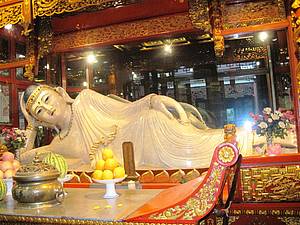
13 - Shanghai - Jade Buddha
Transrapid. We used the train Transrapid train on the way to the airport. It is based on the principle of magnetic levitation (Maglev), as if it were floating on magnetic cushions. It went at 300 km per hour, the journey lasted seven minutes. This train is able to achieve speeds up to 450 km per hour, especially when going to a larger distance. It was a fantastic experience, we were absolutely oblivious of the speed. Transrapid is of German production. Germans developed this train (Siemens and Thyssen Krupp) and wanted to implement it first from Munich city center to the airport and then from Berlin to Hamburg, but ultimately this investment did not pass through the Parliament as the cost was too high. Of course, Chinese did find money for such an investment, so the Germans built the first segment of the rail for them and sold for the patent to Chinese for further use. The Chinese planed to extend Transrapid to the second airport in Shanghai and connect Shanghai with city of Hagzhou, which is 175 km away.
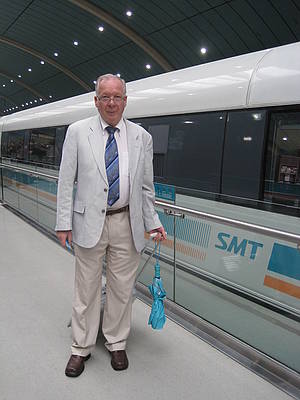
14 - Shanghai - Transrapid Magnetic Train
Yichang, Yangtze Cruise. We reached Yichang tired and the main experience was the offered feet massage which turned out actually to body massage as well. We lay side by side with George on the loungers (for such a type of massage the clothes stay on). A masseur massaged and a masseuse massaged George simultaneously. It was very nice and refreshing for me after a long travel, but George had to be a little more cautious given the state of his aching spine.
That evening we boarded the ship Victoria sailing on the Yangtze River, operated by US-Chinese company. We had a cabin named Shangri La, located on the bow of the boat. It had large windows on both sides and a private terrace so we could watch an interesting landscape passing around either from the easy chair or even from bed. After checking in, we were invited to dinner with the Captain. The ship was equipped with a library and game room, where the Chinese constantly played cards and other board games.
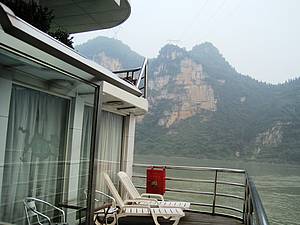
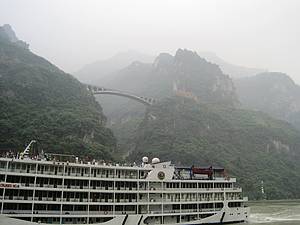
15-16 Victoria Ship on Yangtze River
The first excursion from the ship was by a sampan (native boat) along the tributary of Yangtze Shennog. Whilst Yangtze did not make an impression of a clean river (in some sections people obviously threw their household waste into the water, so that number of plastic bottles, bags and other clutter floated around), Shennnog looked crystal clear, color of azure, fantastic rock landscape with steep cliffs and peaks and lush vegetation (cypress) all along. On the banks there were rock goats, monkeys, singing birds and singing natives (from previously mentioned "minority") to be seen and heard.
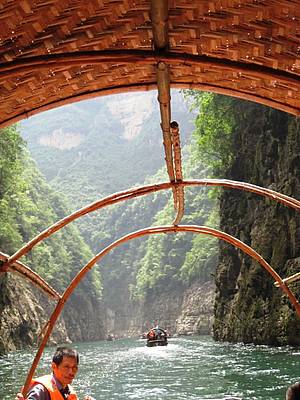
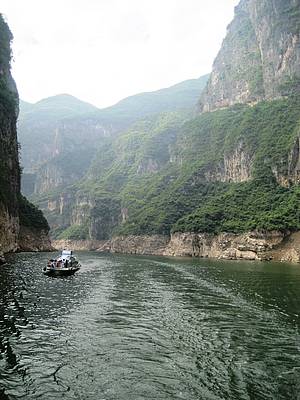
17 - Victoria Ship - Sampan Excursion on Shennong Stream
The next excursion was to Fengdu Ghost City (City of Ghosts) on the Mount Ming Shan. It is dedicated to Lord of Afterworld called Tianzi. On the mountain there are placed various temples, sculptures embodying the creatures of hell, virtues and vices, paintings depicting the torments awaiting all sinners and collection of torture instruments. Due to the construction of Three Gorges Dam Fengdu was quite recently completely moved to the other side of the Yangtze River.
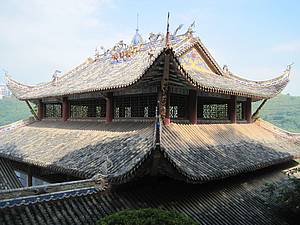
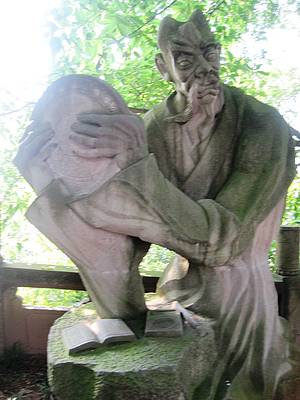
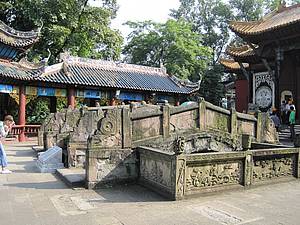
18 - Victoria Ship - Excursion to Fengdu, City of Ghosts
There was a Chinese doctor who claimed to master the art of acupuncture. George let her to use her art on him three times to relieve his back pain, unfortunately without any observable improvement.
Chongqing. We landed in a large port of Chongqing. It is a major city in Southwest China and one of the five national central cities. It has an imposing history and promising future (the business centre full of skyscrapers was already built). The cruises on Yangtze either start or finish here. We could visit only a quarter with former embassies from the time when Chongquing was the capital during the second world war and then the Hú Guang Hui Guan Guild, an old Social Club of immigrants, the oldest house in the city which was furnished with historical furniture, appliances and figures depicting life in home and garden.. The guild served as the seat of immigrant life 300 years ago in the Qin dynasty. Eager to increase the paltry population in Sìchuān, the government encouraged widespread immigration beginning in AD 316. By the time of the guild, the population was 800,000 and rapidly growing as settlers arrived mostly from the Hú and Guang provinces. People came to the guild for legal processing and to worship and celebrate with other new arrivals. Then we flew to Guilin.
Guilin. Famous for its natural beauty, this small town is surrounded by karst limestone formations that reach up to 200 meters. They are concentrated around the Li River, and in many cases there are almost in the middle of the city. During the four-hour ride along the Li river guides constantly stimulate the imagination of tourists – they should not just admire the beauty of formations, but each formation should remind them of something, be it an elephant trunk, fish tail, dragon head, brush holder, or a faithful wife waiting for her husband. The highlight of the cruise is drawing on a monumental limestone rock, which represents nine horses. The number of horses you can identify depends on how developed is your imagination – accordingly you see the number of galloping horses. Great Chairman Mao saw of curse nine of them. However together with George we concluded that he had to be drunk, whatever efforts we made we could not see more than three and also that with some reserve. Guilin owns ten parks, some peaks are part of those. Further, the city has four lakes, with a Pagoda of Sun and Pagoda of Moon in the middle of one of them.
Evening ride on the lakes with fifteen various illuminated bridges and performance of the natives on the banks was one of the most impressive parts. There is also a number of karst caves, the most famous Ludi Yan or Reed Flute Cave with ten meters high tunnels running up to the length of about 500 meters. Everything is lit in colours, the Chinese simply love the neon colored illumination, although for European taste sometimes less would mean more. Local residents found shelter in this cave during the Japanese invasion in 1940. In the evening Guilin can offer one more attraction: the largest man-made waterfall in the world. It flows from a high hotel building in the center - the water is pumped up and the entire hotel is spilled over by streams of water accompanied by colored lights and music every evening for half an hour. From Guilin we flew to Xian.
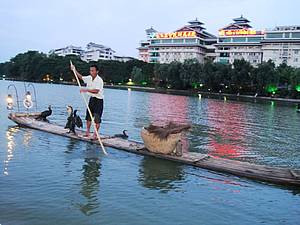
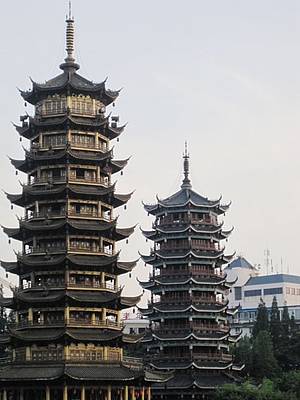
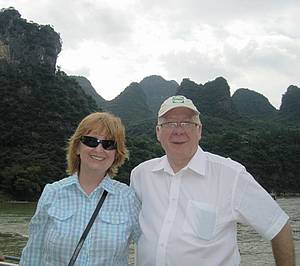
19-21 Guilin - evening cruise on Rong & Shan Lakes, Pagoda of Sun & Moon, Li River Cruise to Yangshuo
Xian. The capital of the empire for 4000 years, last time during the rule of the Tang Dynasty (end of year 907). In addition to the most famous attraction - terracotta army, which I have already described, there are other interesting monuments to be seen, one of the most interesting ones Pagoda of Big Wild Goose with three statues of Buddha and Hanyang Tomb, where is buried Emperor Jing and his wife (a part of the complex of 80 cemeteries and 5000 tombs.) Archaeological work at this complex was interrupted and the tomb is not accessible for the public because when the discovered artifacts were exposed to the air, they lost color and sometimes fell apart. The archeologists decided to wait until new technologies are invented to enable preservation of the artifacts in their original condition.
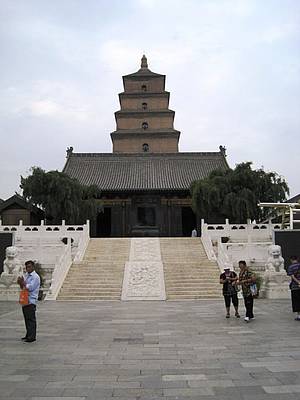
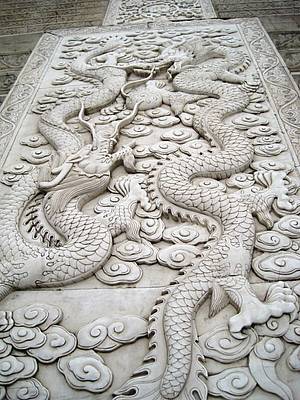
22-23 - Xian Pagoda of Big Wild Goose AD 652
We made a walk into the Muslim Quarter of the Great Mosque, which is shaped like a pagoda, even minaret is not in the shape of a tower, but looks similar to a pagoda. Women in the surrounding streets and at the market wore head scarves in various colors (not black), I saw nobody wearing a burqa. It was in the morning, silence and peace everywhere, only a few people. The mosque is 1,200 years old – about fifty thousand Muslims live presently in Xian and they face no obstacles to profess and practice their faith.
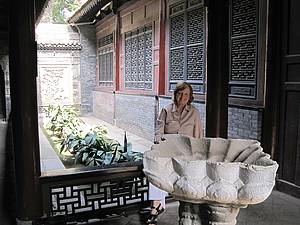
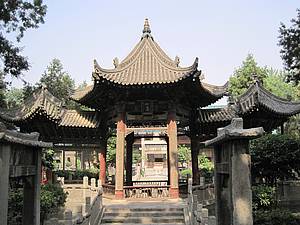
24-25 - Xian - The Great Mosque
We gave up the last parts of the program as we were not keen o walking on the Xi'an city wall at the temperature around 38 degrees. We also were not interested to visit another jade shop which guides in all towns were presenting as a big attraction because they got commission from the sales (normal tourist trap). However we had to explicitly sign and confirm in the evaluation form to filled at the end of stay in every town that the program was not fulfilled because of our requirement, otherwise the guide could lose his job if he would not show us all what was on the agenda. We had a funny incident on departure from Xian to Beijing. George went to a airport pharmacy to buy Kleenex tissues but obviously also in China, business initiative has no limits. The shop assistant offered him on the spot at a really absolutely bargain price sixty tablets of Viagra. It was even more amusing when we thought of the state of George´s spine.
Beijing - Each tour in China´s capital has to include Tiananmen Square and Forbidden City which I have already mentioned and other even more interesting monuments.
Temple of Heaven is the place where the Emperor used to perform once a year an elaborate ritual to ensure a good harvest. The ritual took place in a blue dome which is called Hall of Prayer for Good Harvest. In front of this building there is a round paved alter to be used as a sacrificial site consisting of many stone circles, all multiples of number 9, which is considered by the Chinese the luckiest number. All around is the Echo Wall - one of the great discoveries by Chinese Scholars during the Ming Dynasty was the ability to work with sound transmission. When somebody whispered some words on one side of the wall and another person placed his ear on the opposite side of the circular wall, they could hear each other. This phenomenon was discovered in Europe only much later. But to test it on the spot was impossible. The Chinese are certainly one of the loudest nations in the world (and also there is big number of them), so whispering words so that they could be heard on the other side of the Echo Wall was out of question. Regarding noise, the fact is that Chinese are screaming all the time, when one is standing on the other side of the street, he will certainly not cross but will scream his message to the person standing opposite. The same in the room, a person in one corner is shouting something at the person in the other corner, and of course there is a lot of extremely loud speaking when they have a meal at a round table. Most of the time no silence reigns in China. And even more annoying - they are also pushing each other.
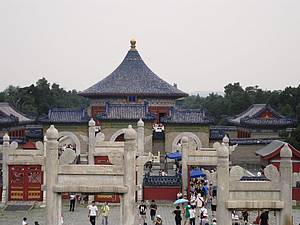
27 Beijing - Temple of Heaven
Summer Palace. It is arranged as a microcosm of nature, its hills (shan) and lake (shui) create a natural composition accompanied by bridges, temples, trails and ceremonial halls. It was a resting place of the emperors, especially the ambitious empress Chixi loved to stay here. In a large park around the lake there is the longest covered corridor in the world. We walked through and returned by a historical Chinese boat.
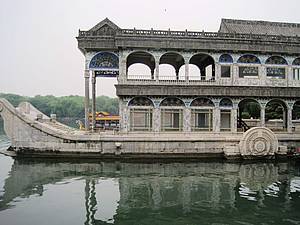
28 - Beijing - Summer Palace
Sacred Road. A path to the ancestral tombs lined with statues of real and mystical animals and mourning willows. The Emperors walked here once a year to perform funeral rites for honoring ancestors.
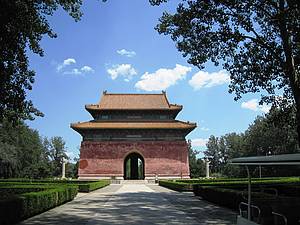
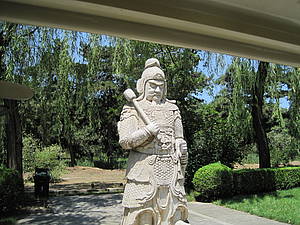
29 - Beijing - Sacred Road
Great Chinese Wall. It measures around 7000 km, of which 60 per cent are accessible. We went to see the part called Banaling, about one hour and a half drive from Beijing. Along the way we saw various other sections of the Great Wall with a similar picture. Huge human anthill (95% Chinese, because it was no tourist season) effectuating difficult ascent and descent in full glow of the hot sun. We joined them just for a small part of it. Great Wall made an impression on us as a big achievement – in spite of its tourist overpopulation.
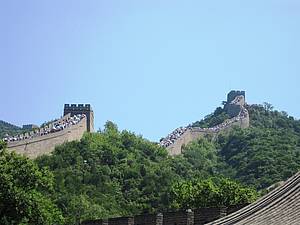
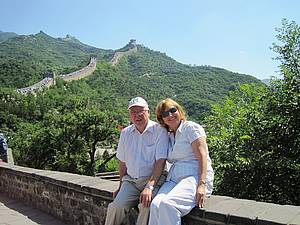
30 - Great Chinese Wall at Badaling
By then the time has come to fly back to Shanghai, to sign contracts with business partners and to return home to Nashik. We flew with transit in Hong Kong, so the first time I could land at the newly built airport (reportedly the largest airport in the world) built by my old friend Roger, who had worked there as a Project Manager.
Holidays with a book. During this holiday, I had enough time to read, especially on the cruises, at the airports and on the plane. In Shanghai, I bought three novels about China, all of them can be highly recommended.
The Piano Teacher by Janice Y.K. Lee. It is set in the span of 10 years starting 1942 in Hong Kong (a city I know so well), occupied by the Japanese. It is a novel about courage and cowardice, collaboration and dedication, as it shows in human beings under such extreme circumstances. The events are intertwined, what started at the beginning of the war has its aftermath ten years later. The point of view of the year 1952 gives the story a proper “ten years after” dimension. The main character is an Englishwoman who marries because of lack of other options a man, seconded to Hong Kong by the British administration in the year 1952. To get some extra money of her own she gives lessons as a piano teacher to a daughter of a wealthy and influential Hong Kong family, which brings her into the center of intricate relationships among the British colonial society and to the center of events which had roots many years ago.
The Painter of Shanghai by Jennifer Cody Epstein. The novel returns to the more ancient Chinese history. In 1913, twelve year old orphaned girl, named Yuliang, is sold by her uncle, an opium addict, to one of the brothels called Hall of Eternal Splendor. The story tells how the girl manages by sheer strength of her will to get out of the most difficult and hopeless situation. She becomes an artist, her talent is widely recognized, but her suffering is not finished because her pictures are too ahead of time, too unconventional - in comparison with traditional Chinese drawings, a painting of a nude woman for which she stands as a model herself shocks the conservative Chinese society. Yuliang is shuttling between Shanghai and Paris, between her work and her husband, who saved her from dismal conditions of prostitution and to whom she therefore feels obliged. In the end they agree that she has to leave China and she manages to do so just before the outbreak of the Second World War. She spends the rest of her life in France.The book is based on a real story.
Life and Death in Shanghai by Nien Cheng. This book was the most surprising one. Nien Cheng based it on her own tragic experience during the Cultural Revolution in the late sixties. Nien Cheng spent in jail over six years without any charge simply because she was different and by that suspicious. She was employed together with her husband by Shell and after Shell gave up their presence in China the company became one of the symbols of capitalist exploitation. Another of her "wrongdoings" was that she was well off - no other offense could ever be proven to her, she loved her country and on purpose wanted to stay out of politics. The main surprise for me was that such extremely critical book could be published and sold in China. The description of life during the Cultural Revolution is absolutely appalling, and it made me shudder to realize that under any similar type of regime it would be certainly also me whose apartment would be plundered and who would be placed into prison, where humiliation and torture were unavoidable.
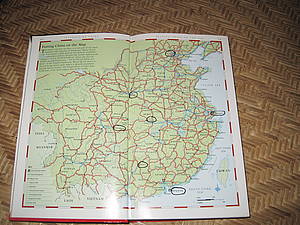
Map of visited places


